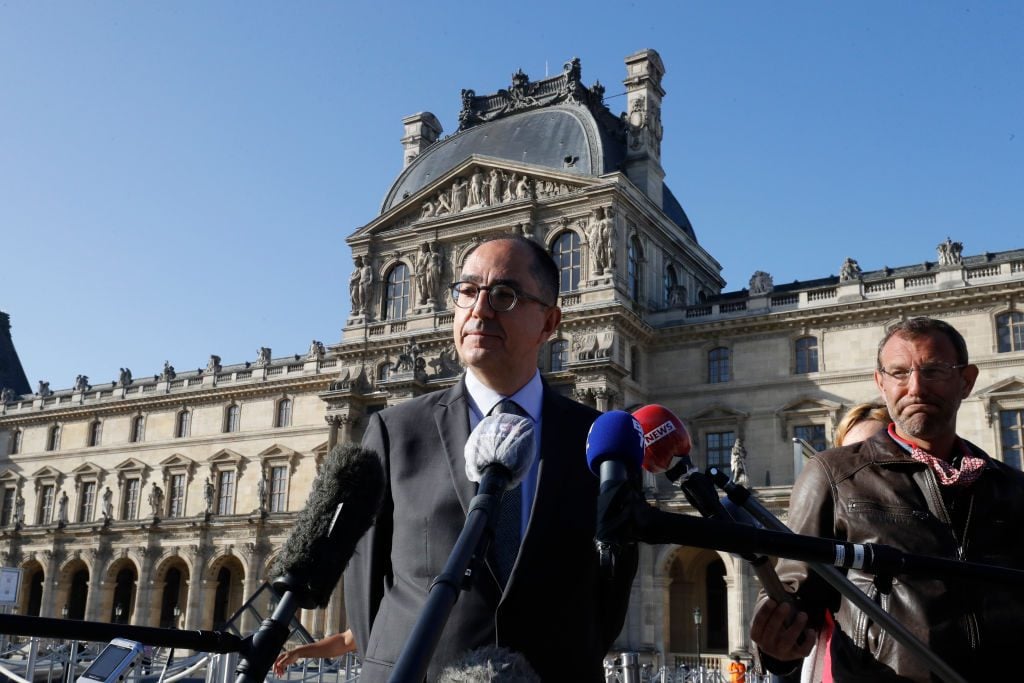Jean-Luc Martinez, the controversial former president of the Louvre, called for a “joint statement” by African and European countries on the principles of restitution in his 85-page report commissioned by French President Emmanuel Macron. Its recommendation is inspired by the Washington Principles on Nazi Confiscated Art set out in 1998.
In the report entitled “Shared Heritage: Universality, Restitution and Circulation of Works of Art; Towards French Legislation and Doctrine on the “Returnability Criteria” of Cultural Property”, Martinez considers cultural property and human remains traceable to former colonies and cultural property looted from Jews between 1933 and 1945, and offers recommendations on how to deal with issues relating to the current African art market. It also offers the solution of “shared heritage” in the form of long-term loans to circumvent complicated restitution criteria.
The report was delivered to Catherine Colonna, French Minister for Europe and Foreign Affairs, and Rima Abdul Malak, French Minister for Culture, last week. It comes amid a scandal that has entangled Martinez, who has been charged by a French court for alleged links to an antiquities trafficking ring,
Concerning the property looted by the Nazis, Martinez proposes to extend the research carried out by the Commission for the Compensation of Victims of Spoliation (created in 1999 by former President Jacques Chirac) to investigate not only acquisitions made between 1933 and 1945 but also on subsequent acquisitions, donations, and legacies of potentially problematic provenance.

Director of the Louvre Jean-Luc Martinez. Photo by FRANCOIS GUILLOT/AFP via Getty Images.
Macron had asked Martinez to think about a future bill on the criteria for the return of cultural property in October 2021 while 26 works have been returned from the Musée du Quai Branly-Jacques Chirac in Benin. The President’s request stems from his promise to Burkina Faso in 2017 to define the conditions for the restitution of African heritage and a report of Bénédicte Savoy and Felwine Sarr published in 2018. Martinez wrote the report in his capacity as an ambassador for international cooperation in the field of heritage.
The report identifies nine criteria for the restitution of African works. Three relate to admissibility: the request must come from the State of origin, not contradict previous bilateral agreements, and there must be an assurance that another State does not claim the same goods. Martinez points out, for example, how Mali and Senegal requested the return of the treasure of Ségou seized by Louis Archinard in April 1890. Mali’s request is based on geographical reasons because the city of Ségou is in Mali, while the Senegal claims “to be the heir to the Toucouleur Empire”, Martinez said.
Two other points concern any illegal or illegitimate nature of the acquisitions. These criteria seem partly intended to protect the French national collections from the risk of being heavily impacted by the innumerable requests for restitution. The report refers to how the musée du quai Branly-Jacques Chirac examines 182 objects whose cases of provenance seem dubious out of 79,614 African objects, while the musée de l’Armée, the museum of the French army, examines about 760 to 780 objects. Additionally, the report calls for a thorough risk assessment at major French museums and collections, including the Louvre.
The remaining four criteria are ‘contextual’, indicating that there must be a willingness to cooperate on the part of the requesting State, which must commit to preserving heritage and presenting cultural property to the public; the requests must be “targeted”, and be limited to patrimonial and non-financial compensation.
After making several trips to Africa over the past year, Martinez concluded that countries on the continent do not all share the same stance on restitution. He writes: “While some states like Senegal want a massive return of works, other countries do not seem particularly demanding at this stage or are very far from this type of concern.
Implications for the art market
Martinez and his two collaborators, Benoît de Saint Chamas and Jean-Gabriel Leturcq, had long discussions with African specialists as well as jurists, museum professionals, historians, politicians, artists and diplomats. During these conversations, they also identified another major problem: how African countries are excluded from the contemporary art market and cannot afford the works of their own artists. Martinez quotes the remark of several African interlocutors: “Today there is a new looting of African art: contemporary African artists go abroad, their market value increases, and their creations are therefore no longer accessible to museums Africans.
Thus, Martinez proposes the creation of a public-private Africa-Europe fund with the dual objective of financing provenance research and the acquisition of African works of art likely to enrich existing or future museums on the continent. African.
Martinez also discusses how wars and conflicts in some countries that have sent restitution requests to France “unfortunately delay the processing of files; this is particularly the case in Mali and to a lesser extent in Chad or Ethiopia.
Another big takeaway is Martinez’s suggestion of a “shared legacy.” This notion would favor the accessibility of works by “authorizing a form of permanent deposit involving the common writing of a common history of objects”. Martinez also recommends further research in museums into works that may have been seized during the wars and examining the provenance of proposed donations and bequests.
The subject of restitution, writes Martinez, is rooted in a complex debate on the “universalism” of art which questions the relationship to the past, questions the role of museums in the 21st century, and their missions of sharing and promoting knowledge.
More trending stories:
Follow Artnet News on Facebook:
Want to stay one step ahead of the art world? Subscribe to our newsletter to receive breaking news, revealing interviews and incisive reviews that move the conversation forward.
